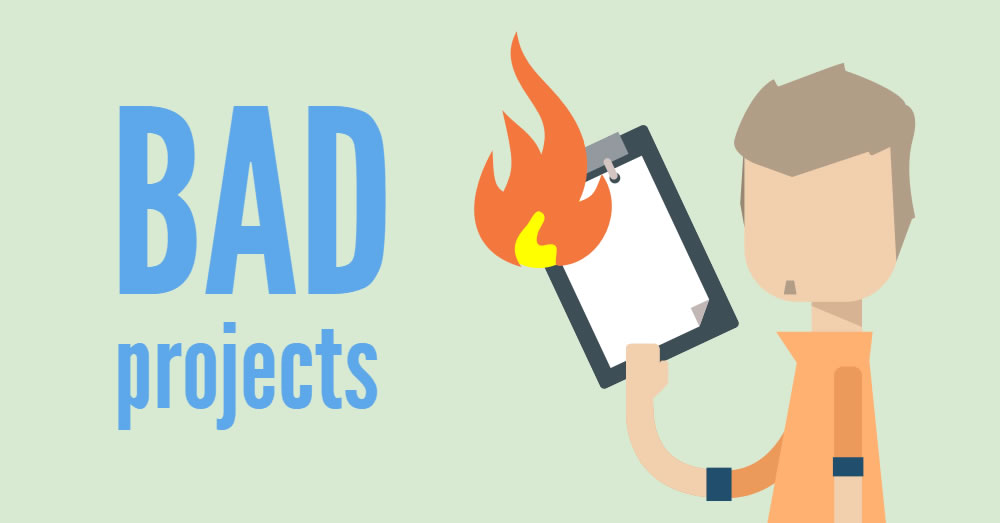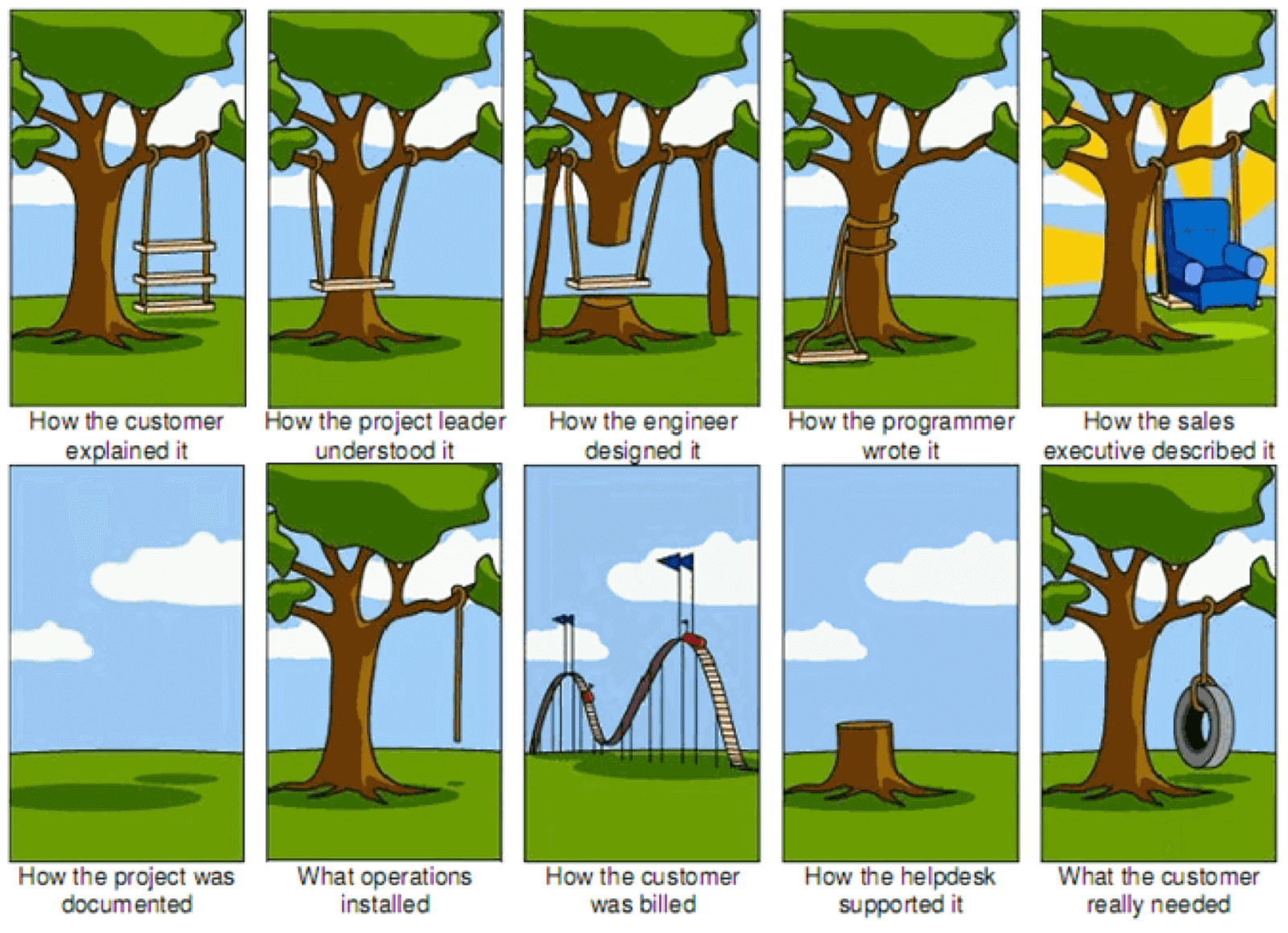- 01
Poorly defined (or generally uncertain) result
"Mobile app? We are building a bridge, will they need it? ”
One of the biggest problems hindering software development is a poorly defined result. Without a proper definition of what the “final product” should be, the project is guaranteed to fail.
Determining the result is very important. The project can change direction and you have to say goodbye to all the work you did (that's why it is # 1 on our list!). We highly recommend compiling a specification to better determine what the product will look like, what it will do and how it will do it.
- 02
The solution to the wrong problem
“We built a new wooden bridge that looks much better than the old one. Cars? No, cars cannot drive on it.”
Another common problem is the solution to the wrong task. This partly coincides with a poorly defined result, but, in general, is much broader. Although you can correctly determine the final product and correctly solve the other problems that we are discussing here, if your product does not solve the problem properly, you will not achieve anything. As a result, you’ll just get yet another unsuccessful project.
One way to deal with this issue is incremental implementation. Define your main task, what steps can be taken to solve it and possible approaches to it. Then, constantly update the product receiving feedback from your users. Regularly check your team’s tasks and your realisation. This will make sure that the project meets your customer’s needs properly and is the solution to the main problem.
- 03
Lack of communication
"We built half the bridge; they built half the tunnel."
Almost all projects, industries and companies suffer from this problem. Communication is vital at every level of a software development project.
Internally, your developers must communicate effectively with each other. This ensures the creation of the right tools and conveyors that are consistent and compatible. A common solution here is to develop preliminary specifications for the design, API, and any other technical requirements needed for your project. This is vital to saving hundreds of hours that would otherwise be wasted on refactoring and restructuring.
At a higher level, it is also important to communicate with other teams correctly. For example, a marketing team needs to know what is technologically feasible before selling a concept.
- 04
Lack of plan or deadlines
“Yes ... it will be ... in a couple of weeks? Not sure what we will do after this ... ”
Regardless of whether deadlines and plans are being followed, it is important to have them. They are the framework of your project. It will give you at least a rough estimate of when and how tasks will be completed.
Of course, a good plan is much more than that. A good plan or schedule for large teams can serve as a common boundary, which will allow them to work quickly and efficiently in sprints. If the implementation of the function fails or requires more time, then the plan/schedule can be quickly adjusted, and after that, the budget can be changed.
- 05
Lack of responsibility
“The ship doesn't go any further!” - probably Harry Truman.
When a certain type of uncleanliness hits the fan, someone should be ready to clean it with a mop. If any function fails, it should be clear who is responsible and what steps should be taken to prevent this in the future.
It may sound childish, but in the development industry, the usual thing is to shift responsibilities. Backenders blame the front-runners who blame the sales department, which blames the marketing, which blames the lawyers, who blame the management ... This process is not only time-consuming and destructive for the morale of the company, but also, it leaves the main question “what went wrong?” open and unanswered.
- 06
Changing goals too often
“Well, but now the bridge should work as a runway, have 10 more runways. And what about the park in the middle?”
It is important to keep track of the projects goals and monitor their timely implementation, otherwise you will just go nowhere with your project. It is possible that the project will need to be expanded or the requirements will change. But frequent changes in the “ultimate goal” can not only destroy the morale of the team but also make it impossible to complete the project as such. Often changes are not planned and require a lot of refactoring. Over time, this leads to large losses of time and, ultimately, to the failure of the project.
What at first glance may seem like a small change can ultimately become a big project.
- 07
Inadequate documentation and tracking
“The instructions for defusing the bomb say you need to cut the red wire as soon as the power goes out, but all the wires are red, and the power should have been turned off 10 minutes ago!” - James Bond at the end of his career.
You can follow a flexible methodology and move forward quickly, but documentation is always important. An undocumented code can lead to years of technical debt and cause huge what-does-this-function-do-type of problems in the future. An unsuccessful project will be swarming with such difficulties.
It is very important to document the product. Every step of the process, from idea to design and development, needs to be well documented to ensure that the project is navigated and tracked easily. Good documentation makes keeping track of key milestones in a project really simple.
- 08
Poorly defined system requirements
“Damn it, you mean that for 5,000 people we only have 5 loaves and 2 fish?!”
Design specifications can be difficult to measure. But you must identify them. What may seem like a small addition may well turn into a big problem that needs additional infrastructure and redefining the entire system to implement support.
- 09
Poor preparation
"We still have half the ship."
Often the project is fascinating, and it’s easy to “enter” it. However, proper training is vital for this. It is necessary to create specifications, develop a design system, coordinate deadlines and allocate resources.
A popular way to manage this technically is Test Driven Development. Before writing one line of code for a project, plan the architecture and what each part needs to do. Then write tests to understand that each piece does what was intended. Thus, you will have a ready-made structure with goals set, and you can quantify the progress in developing your product.
- 10
Unrealistic expectations
“Great, the application looks perfect. But why doesn’t the color scheme change automatically according to the user's clothes?”
It is important to manage expectations. Often a client requests an unreasonable, impractical or impossible function. It is common practice to limit the number of changes that can be made to a specification. The presence of a programmer during discussions is also required. He will be able to determine if the function is technologically feasible. An unsuccessful project tries to realize all the Wishlist at once.
We hope that next time you will avoid these 10 traps, and your next project will be a resounding success! What problems did you encounter in your projects? Email us at info@geniusee.com

























